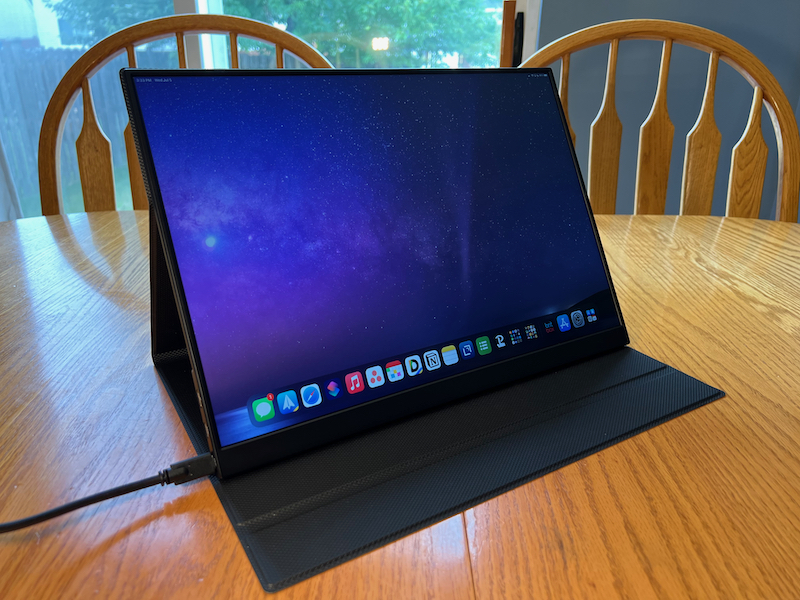
REVIEW – I like using multiple monitors. I’m not a stock trader or gamer but I’ve used many setups over the years with multiple monitors and I’ve always enjoyed being able to keep multiple things in front of me so I can have an app for writing on one monitor, while keeping an eye on a video or movie, or whatever else I want to do on a second monitor, and sometimes even have a third monitor for a clock or other status information right there in front of me. That’s the approach I took with this review of the MagicRaven 16” 2.5K 3:2 Portable Monitor – how can it be useful to me as a second monitor with either my laptop or iPad Pro?
What is it?
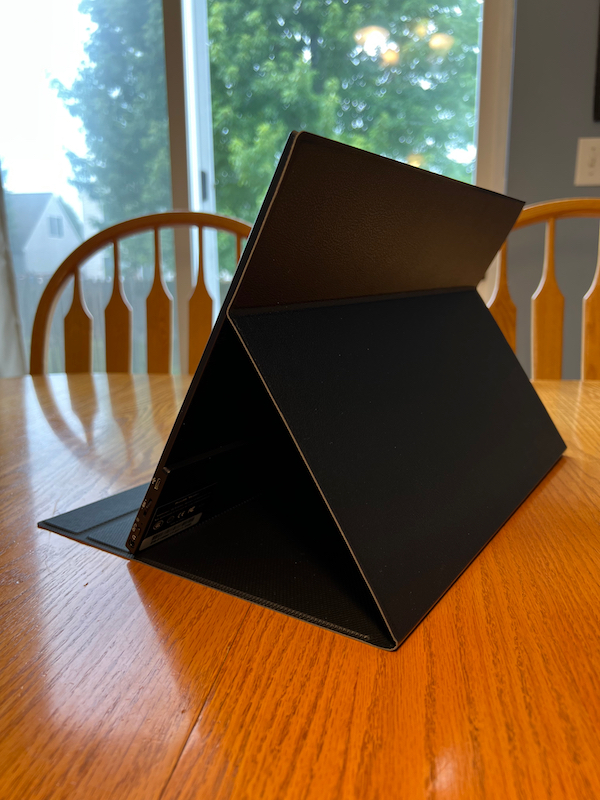
The MagicRaven 16” 2.5K 3:2 Portable Monitor is a lightweight, slim, high-resolution monitor designed to be carried around as a second monitor for a laptop, an iPad or similar tablet, or a game console.
What’s in the box?
- 16” Portable Monitor
- Detachable Cover
- USB-C to USB-C Cable
- HDMI to Mini HDMI Cable
- USB-A to USB-C Cable
- Power Adapter
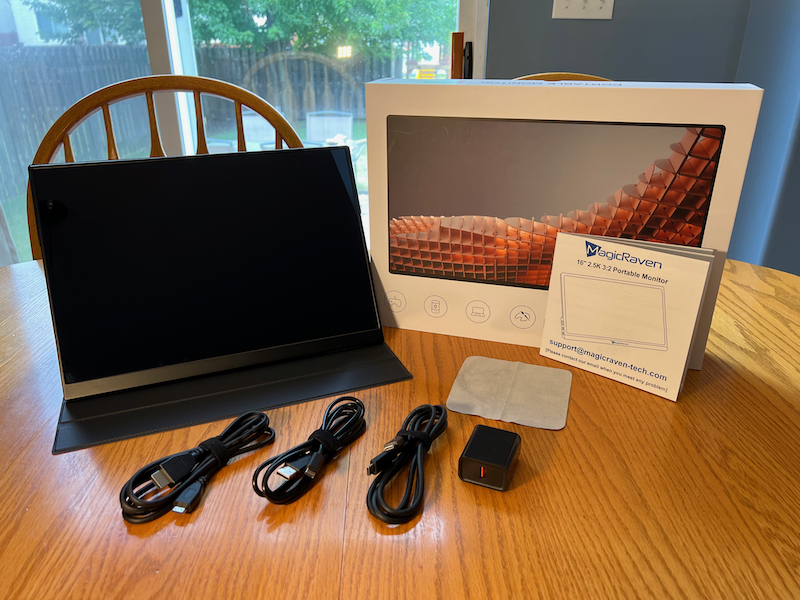
Hardware specs
- Model Number: M1601
- Visible Area: 13.32 x 8.88 in (338 x 255.6 mm)
- Panel Type: IPS LCD
- Resolution: 2520 x 1680
- Display Colors: 1.07B, 100% DCI-P3
- Color Gamut: sRGB 100% Typ; 95% Min
- Contrast Ratio: 1500:1
- Brightness: 300 cd/m^2
- Aspect Ratio: 3:2
- Speakers: Built-in Speaker x2
- Visual Angle: 178°
- Product Dimensions: 13.74 x 9.72 x 0.35 in (Max) (349 x 247 x 8.9 mm)
- Weight: 2 lb 3.4 oz (1 kg)
- Headphone Output: 3.5mm Headphone Interface
- Inputs: Mini HDMI (Video signal); Dual Type-C Full Featured (Video/Audio & Power); Micro USB for USB Mouse/Keyboard (Need USB-A to Micro USB adapter, not included).
Design and features
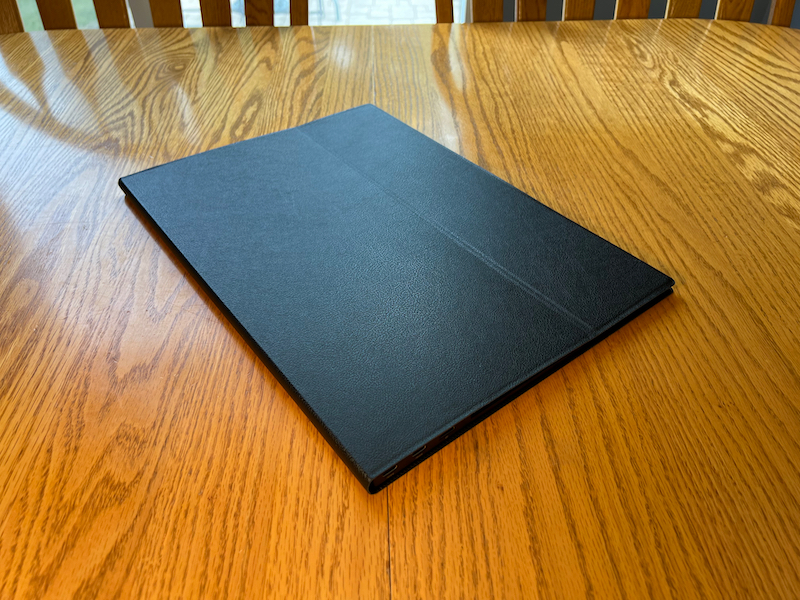
The MagicRaven monitor is a 16” monitor with a 3:2 aspect ratio. The body of the monitor is made from black plastic and the screen is glass. The main body of the monitor is extremely thin with the lower part of the back being thicker to accommodate input and output connections, control buttons, and the two speakers on the back. The back of the case is textured, which helps reduce smudges and fingerprints, although they do still show up. The included cover also acts as a stand, allowing the monitor to stand at two different angles; it is also removable if you prefer to use another method to prop up the display. The included cables and power adapter are well-built and feel like they’ll last.
With a 3:2 aspect ratio, this display takes a little getting used to. It’s slightly taller than your typical widescreen monitor, but not as close to square as an old 4:3 monitor. For certain types of use the extra vertical space comes in handy. Editing in apps like Final Cut Pro or Logic Pro benefits from the extra space for more tracks or layers. Since it’s a lot of resolution – 2520 x 1680 – on a relatively small screen, text and user interface elements get shrunk down, but in an editing app that’s sometimes less important than being able to see more of the media you’re working with on screen without needing to scroll around.
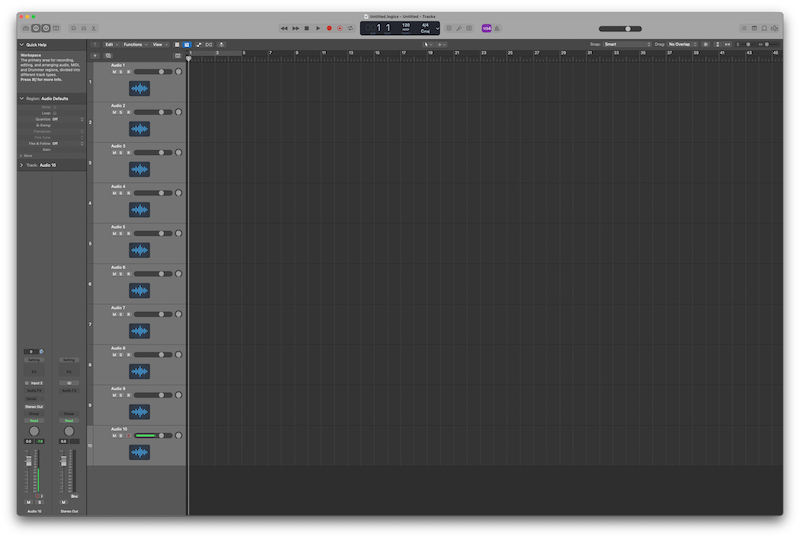
The sRGB and DCI-P3 color capabilities and 1500:1 contrast ratio put this monitor in a good range for color accuracy and picture quality. Brightness goes up to 300 nits, which is a little low for an HDR monitor, but with brightness and contrast set to high, or in HDR mode, it’s more than acceptable for viewing, especially if you have control over the ambient light in the room. Speaking of ambient light, this display is very reflective, so be careful where you place it or you may see unwanted reflections.
The MagicRaven 16” monitor has dual USB-C and a single mini HDMI input, so you can have up to three sources connected and easily switch between them with the power/return button and the menu scroll wheel.
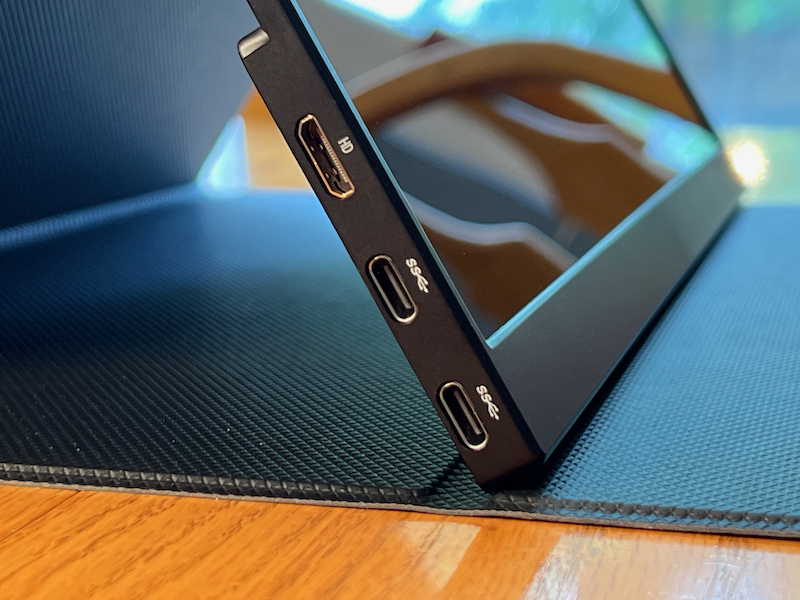
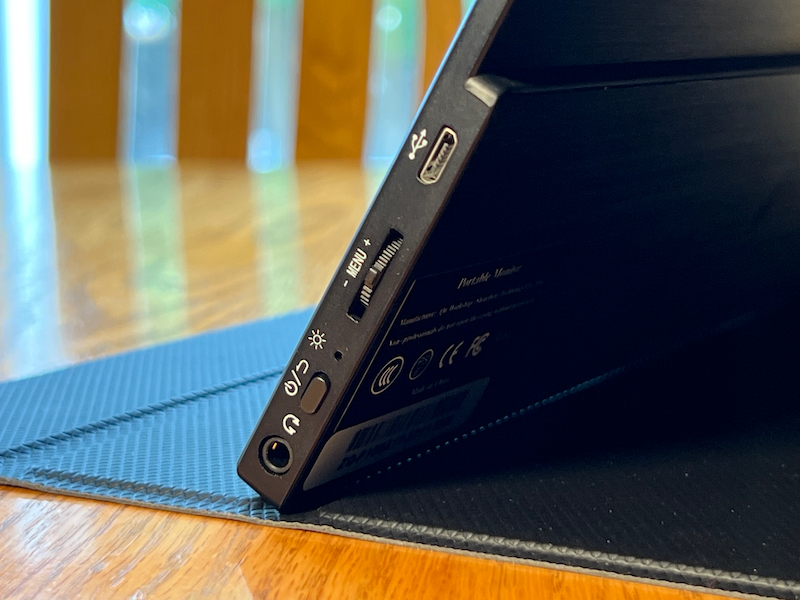
Installation and setup
After unboxing the monitor, unfold the cover and choose the angle that best suits your environment. If your computing device (computer, tablet, certain phones, etc.) supports power and video over USB-C, all you have to do is plug in the cable at both ends and wait for your device to recognize the display. For me that worked instantly; I didn’t even have to choose which input I was using, as long as I only had one display cable connected. If your computer has an HDMI output, or can be adapted to mini HDMI, then you’ll need to power the monitor separately using the included power adapter and USB-A to USB-C cable. MagicRaven says in the manual that if you want to run the screen at full brightness or volume, and you’re connected by USB-C, then you may need additional power provided by the adapter. I didn’t come across this with either my MacBook Pro or my iPad Pro or the powered docks I tested it with, but be aware that this might be a possibility.
When I first plugged the monitor in it defaulted to HDR being on. This caused the display to look muted and the colors and contrast were off. I set HDR to off when I wasn’t sending it an HDR signal because auto didn’t always turn off HDR correctly with my MacBook Pro, although it seemed to work right with my iPad Pro. While using it with my Mac, I’ll just get in the habit of turning HDR on and off manually, unless it works better with a newer computer when I eventually upgrade.
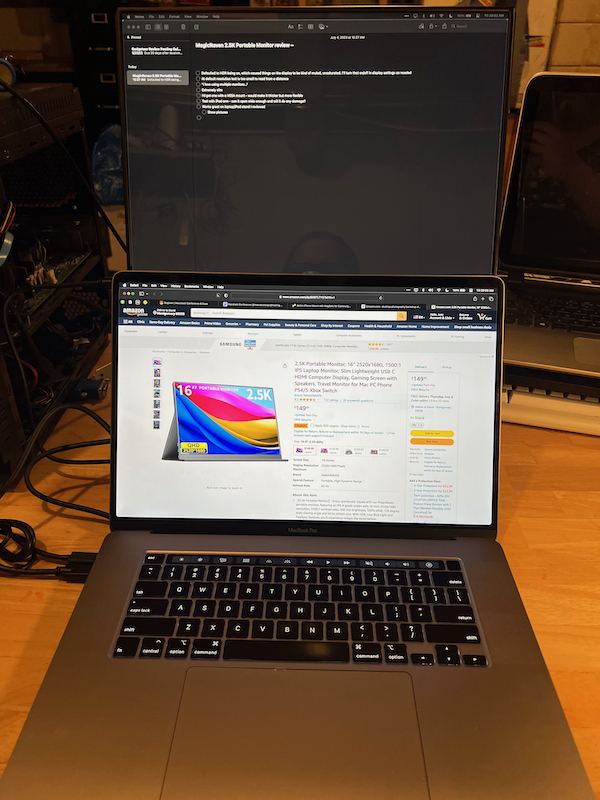
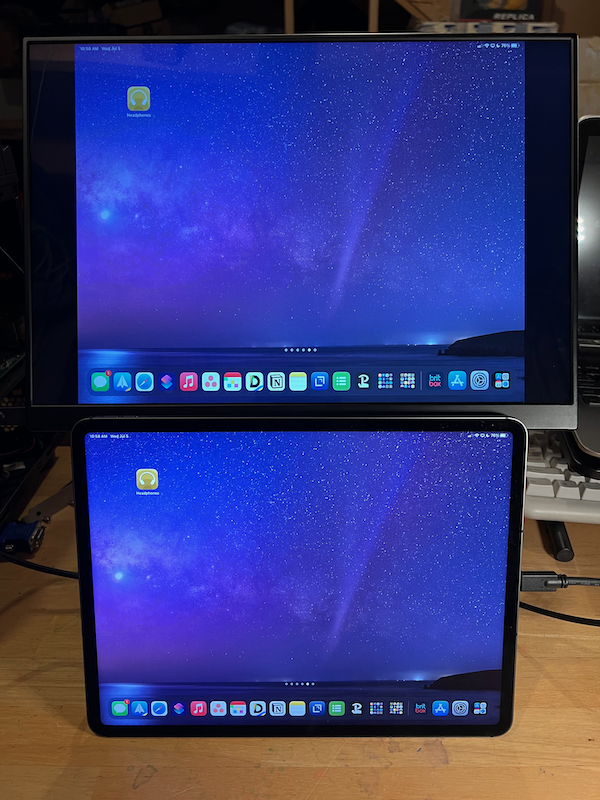
If the MagicRaven 16” monitor’s default display settings work for you, then there’s nothing else to do. If you want to tweak color, brightness, or other monitor settings, press the menu wheel in and scroll around and make the changes you want. Here are some of the settings you can change in the menu system:
- Brightness
- Contrast
- DCR (Dynamic Contrast Ratio)
- Aspect Ratio
- Color Temp
- RGB Levels
- Language
- On Screen Display position, transparency, and timer
- HDR Mode (Off, Auto, 2084)
- Low Blue Light
- And more…
In use
I’ve used the MagicRaven 16” 2.5K 3:2 Portable Monitor while editing some audio in Logic Pro and the extra vertical screen space has come in handy. When trying to see a lot of tracks, or zooming in on just a few tracks, it’s been nice to have that extra space to use without having to scroll as much. It also comes in handy with Final Cut Pro and similar video editing apps. The smaller size of the user interface is noticeable, and not as useful from a distance as a larger monitor would be, but it’s an acceptable compromise for this type of use. For projects that require more writing or looking at a lot of text like email or writing this review, setting a lower screen resolution (or the interface scaling option in Windows) is required to get the text size to be large enough to read without magnifying glasses.
For text-based use of this monitor, I set my MacBook Pro’s output to 1260×840, which is half the resolution in both the vertical and horizontal axes. This brought the text up to a size comparable with the 16” screen on my laptop. It wasn’t as sharp as the built-in display, but it was more than legible and usable for what I was doing. Time will tell if that’s a good long-term solution. I am considering trading in my laptop for an M2 Mac mini and using my iPad Pro as a portable device, along with an older work-provided MacBook Pro. If I do end up going this route I’m definitely going to try using this as a primary monitor with the Mac mini and see how well that works. It’s a little smaller than I prefer for a desktop computer, but it will be an interesting experiment to save desk space, and save money by not having to buy a new monitor. One thing I noticed when I set the output to this half resolution was that the monitor still showed that it was receiving a 2520 x 1680 signal, which means the Mac is sending full resolution and scaling up everything internally; the monitor is not doing the scaling in this case.
I have an old PC with VGA and DVI outputs but I don’t have a way to adapt that to USB-C or mini HDMI so I was unable to test this with a proper Windows PC. I do have Windows installed under BootCamp on my MacBook Pro so I tested that with this monitor. As on the Mac and iPad Pro, Windows recognized the monitor and set it to the correct resolution right away. Unlike the Mac, however, there was no way to send a different resolution. The resolution option was grayed out and no amount of poking around in the display settings allowed me to choose anything other than default. One option that was there, however, was the option to scale user interface elements, which I set to 200%, which worked better, and looked a lot crisper than the Mac’s output at half the resolution. I assume the lack of resolution choices was due to the fact that this is running on Mac hardware with Mac drivers rather than standard AMD or NVIDIA drivers on a regular Windows PC. HDR mode was also more consistent on Windows, allowing me to leave the monitor set to Auto and turn HDR on/off in the OS settings instead.
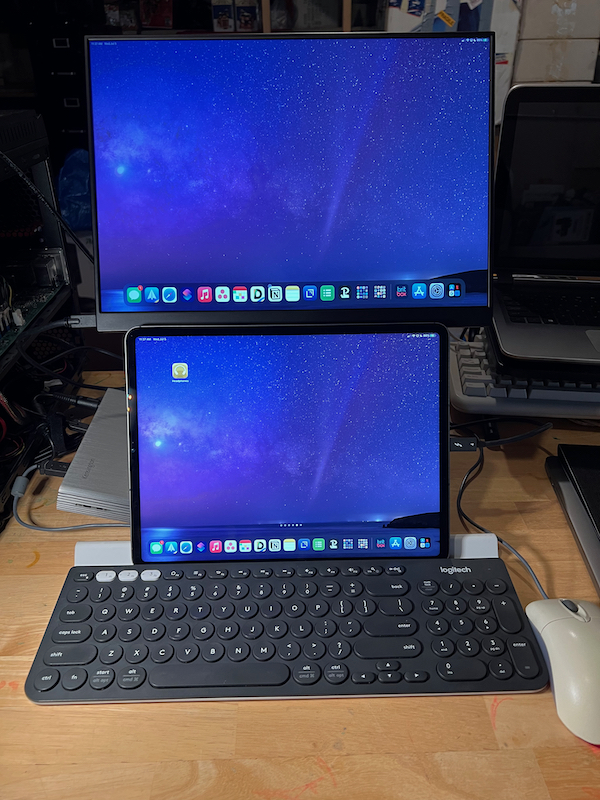
The included USB-C cable didn’t work with the Logitech case on my iPad Pro. This is something I’ve seen with other cables as well as the Thunderbolt 4 cable that came with the Kensington dock I reviewed a while back so it’s definitely not MagicRaven’s fault. This is unfortunate, though, because the case has a detachable keyboard and trackpad that connect through the iPad’s Smart Connector pins, which means it doesn’t require power or Bluetooth. I do have a good Bluetooth keyboard and a wired mouse that I like to use anyway, so this isn’t the worst problem, but I don’t like having to remove my iPad from its case for setups like this.
I also tried the monitor with the Baseus USB-C dock I reviewed, and that worked as well, but it required external power and the HDMI to mini HDMI cable for the monitor, doing away with the single-cable solution. That dock’s USB-C connector fit properly with the Logitech case on my iPad, so that was a plus. If I do end up using this setup more often, at least all I would have to do is unplug the single USB-C cable from the iPad and I’d be ready to go.
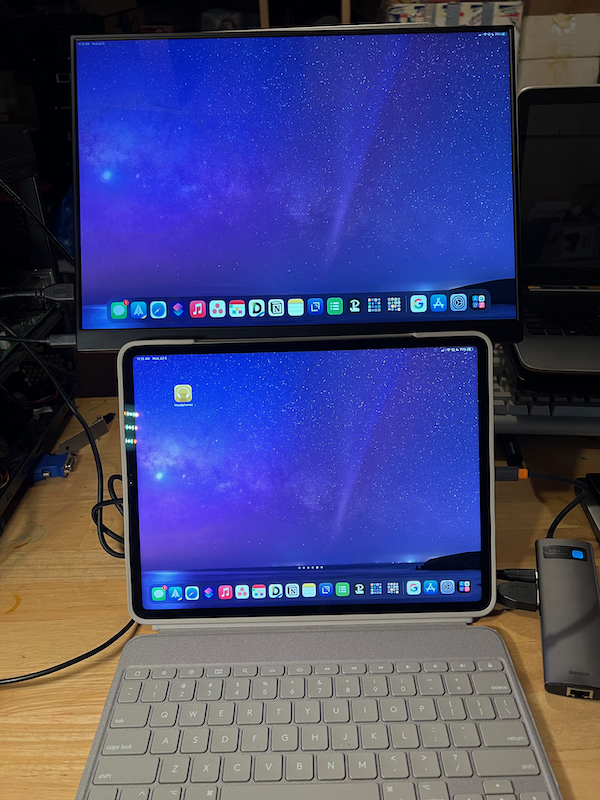
At just over 2 pounds the MagicRaven monitor is extremely lightweight. This means you can easily grab it and go, especially if the device you’re using it with sends video and power over USB-C. Be careful when transporting it, though. I know of a podcaster who recently traveled internationally with a similar portable screen and it was cracked when he arrived. This monitor is similar in size (not thickness, though) to my 16” MacBook Pro, so I would transport it with the screen facing the body of the laptop, although depending on what else I had in my backpack, I would still be concerned that something might cause it to bend or crack. The included cover is nice but I don’t feel like it would provide enough protection for this kind of travel. Just something to keep in mind.
Speaking of the cover, it is removable if you don’t want to use it. It’s magnetically attached to the upper third of the display. In my setup, I used the monitor with the obVus minder Tower Stand 2.0 laptop stand I reviewed last year since the top part can be angled so high. This turned out to be a perfect height for holding the monitor above my laptop’s display, or my iPad nestled into the slot of my Bluetooth keyboard, which makes a perfect compact dual screen setup for either device. There are rubber pads on the two fingers that stick out and hold the display so I’m not concerned about it slipping around or falling off very easily.
Given the choice I would go with the model that has a VESA mount option built in, allowing for more flexibility in mounting options and placement. That would undoubtedly make the monitor thicker, but it’s a compromise I would be willing to make unless portability was the most important thing, which in my case it isn’t. The good thing is that MagicRaven makes multiple versions of this display or similar ones, including a couple with VESA mount options, so make sure to choose the one that works best for your situation when purchasing.
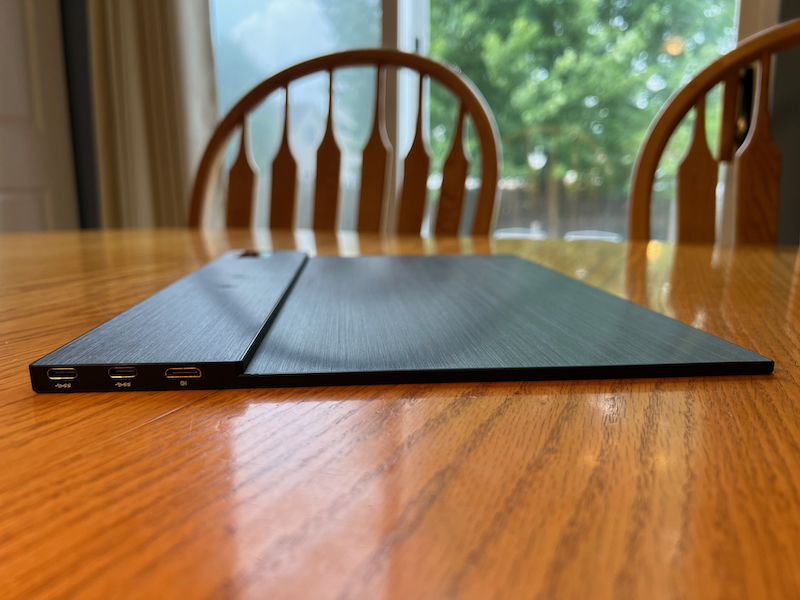
The MagicRaven 16” 2.5K 3:2 Portable Monitor has built-in speakers with grills on the back to let the sound out. There isn’t much to say about these speakers other than the fact that they work. Because of the thinness of the monitor there isn’t much room for the speakers so the frequency range is pretty limited. They also don’t get very loud. Thankfully they’re clear and not distorted so if you just need something for watching an occasional video or just for alert sounds, you don’t need to set up external speakers.
There are three shortcuts to what are some of the most used menu items – volume, brightness, and input selection. For volume and brightness, you scroll the menu wheel up or down to select one or the other, then scroll up and down to change settings while the option is displayed on screen. In HDR mode the brightness setting is grayed out. For input selection, press the power/return button, then use the scroll wheel to choose the option you want and then press in the scroll wheel button to switch to that input.
Overall I really liked the quality of this display. I’m not monitor or color expert, but I do recognize the specs they mention and I know they’re good. Viewing some HDR test footage on YouTube looked very crisp and clear, and the colors were vibrant. I decided to try a test between this monitor and my laptop’s display, which is not a bad display at all, and I was blown away by the depth of color and the contrast ratio, especially the deep black levels that it attained. In the photo below I set up Safari on the MagicRaven monitor and Chrome on the MacBook Pro and took a picture of the difference. As mentioned, colors were more vibrant, black levels were darker, and in Safari on the external monitor the transition from the red liquid to the blackness behind the bottle was much smother; Chrome rendered a much sharper edge between the red liquid and the white edge of the bottle. Not sure what Safari is doing different, but I much preferred that look. I swapped the browsers, putting Chrome on the external display and it had the same sharp edge as it did on the MacBook’s display. I also did the same test with Chrome and Microsoft Edge in Windows with the same results – all browsers other than Safari rendered a hard edge between the red liquid and the white shine on the edge of the bottle. I know this isn’t a browser test it was just something I found interesting during testing.
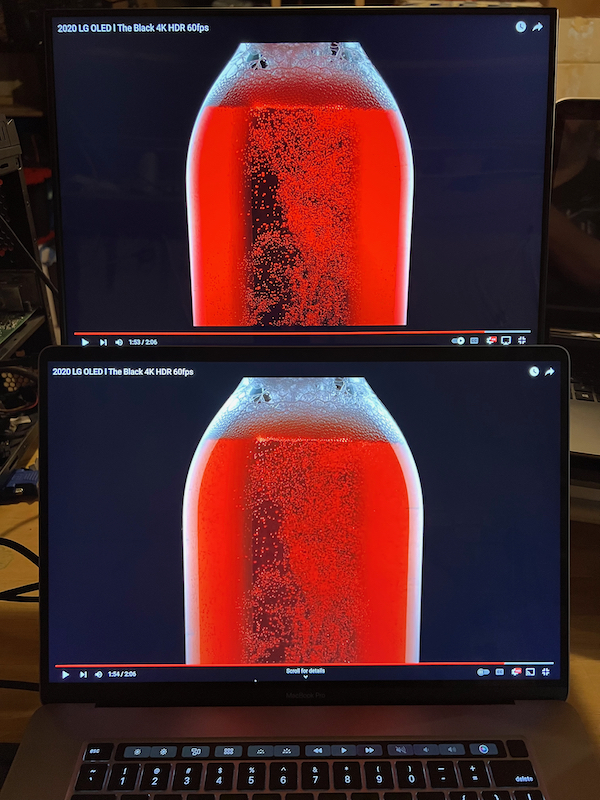
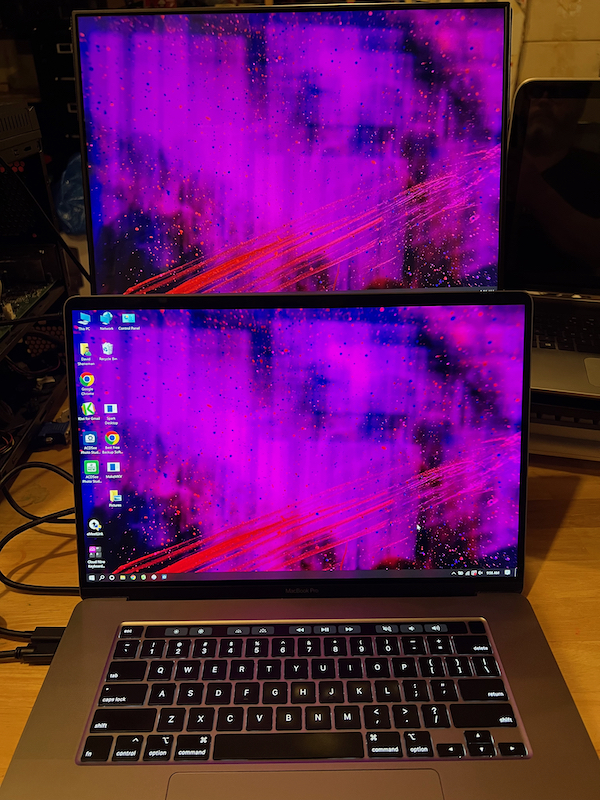
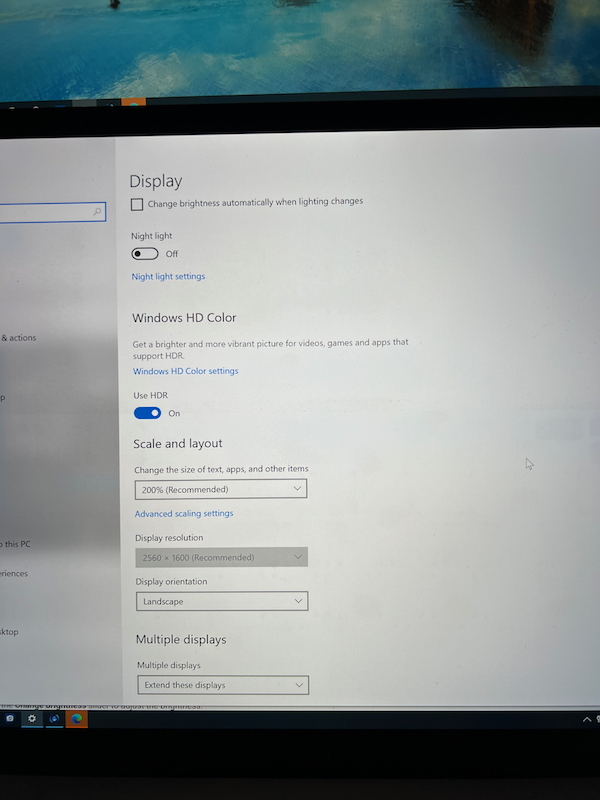
Finally, there are three negatives I found with the MagicRaven 16” 2.5K 3:2 Portable Monitor, one slightly more annoying than the others. First, as mentioned above, I wish it would get a little brighter. At 300 nits, at full brightness and contrast, I was able to get a picture I could work with, in a basement where I can control ambient lighting. If I was in an office with more natural light coming in, or with lights behind me, reflecting off the monitor, it would be more of a problem for my use.
The second negative, and it’s a very minor one, is that the name of the monitor just shows up as “Display” in macOS, Windows, and iPad OS. Admittedly if this was the only monitor being used, or if it was being used as a second monitor, this really isn’t going to be a problem. I’ve used setups with 4 or more external monitors or other video display/recording devices hooked up, and managing which monitor goes to what destination, without the option of custom names for each, was always a big challenge. Naming it MagicRaven or even the model # of the display would be extremely helpful in those kind of situations. Not a problem most people are going to have to deal with, but it is something I’m always looking for.
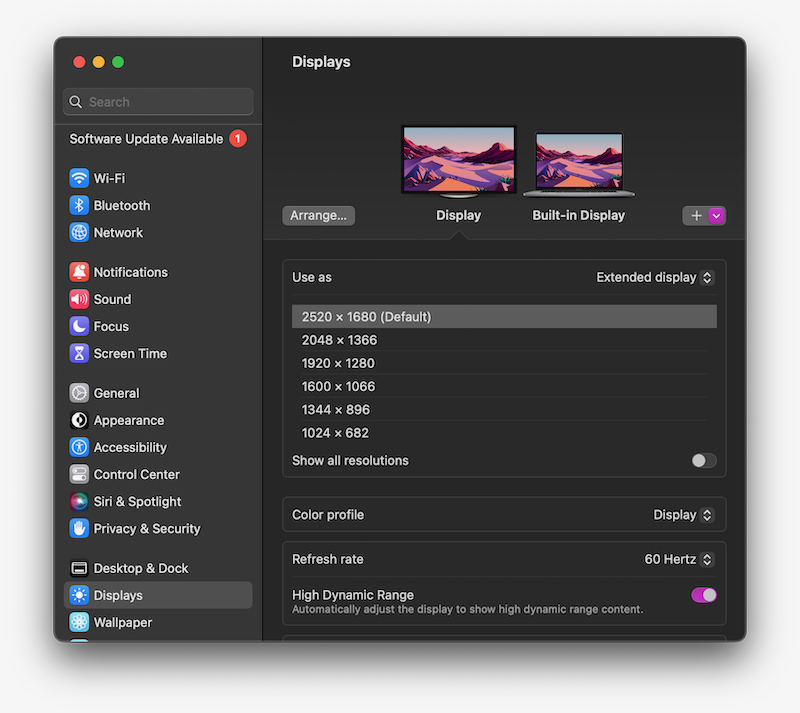
The last negative, and the most annoying to me, is how hard it is to press in the button on the menu scroll wheel. I’d say I probably had at best a 40% – 50% success rate every time I tried to push the button in. It’s impossible to do without holding the other side of the display and even then I almost always had to use my fingernail. Just using the skin of my fingers almost never worked. I don’t expect to be changing display settings every day, or probably not even every week, but this kind of usability problem is frustrating.
What I like
- Single cable use for power and video/audio
- Light weight
- Slim
- High resolution
- Plug and play – no drivers
- Shortcuts to important menu items with side buttons
What I’d change
- Increase brightness
- Name it something other than Display in OS settings
- Make the scroll wheel easier to press in
Final thoughts
As long as you can deal with the admittedly minor negatives I mentioned, the MagicRaven 16” 2.5K 3:2 Portable Monitor is a good quality, lightweight, capable monitor for not a lot of money. It can be used at home or in an office in a permanent setup, or carried with you without needed extra power in most cases, and is high resolution enough to look good for most of the work you may want to do. If you need a portable monitor, this is a great option to consider.
Price: $149.99
Where to buy: Amazon
Source: The sample for this review was provided by MagicRaven.

